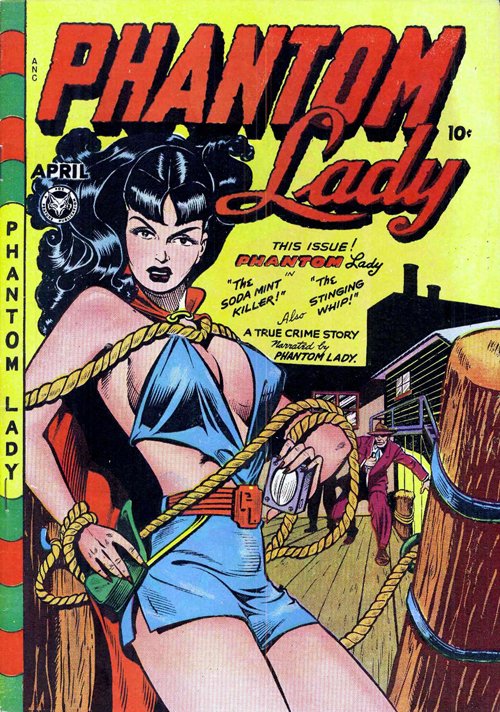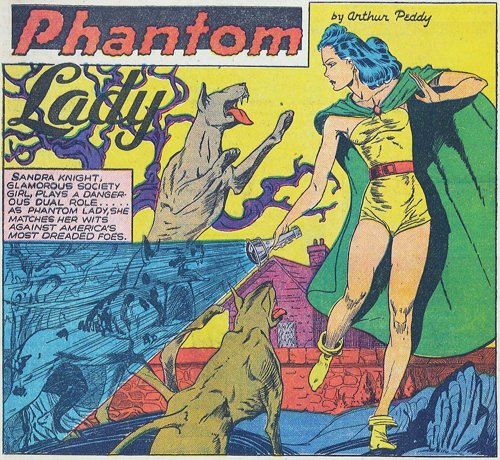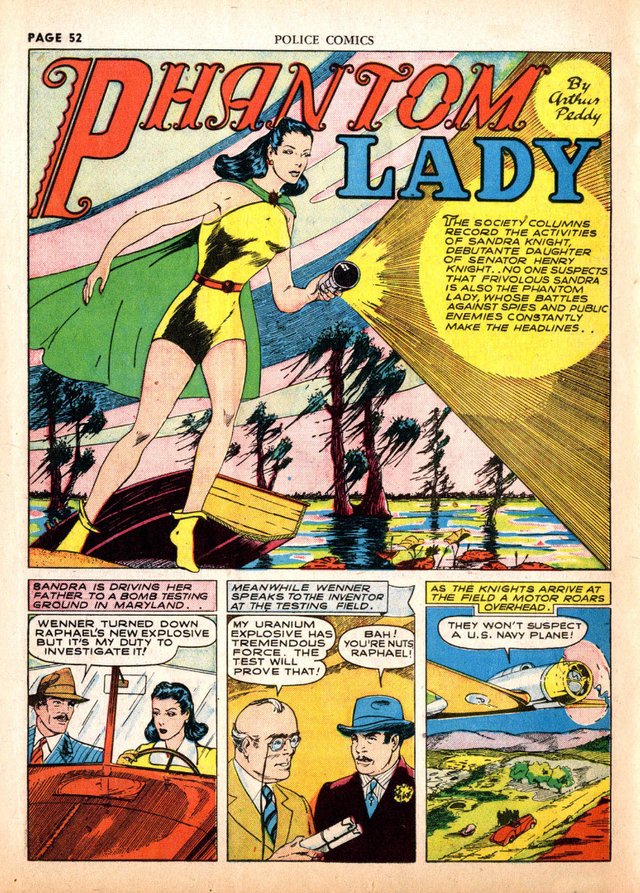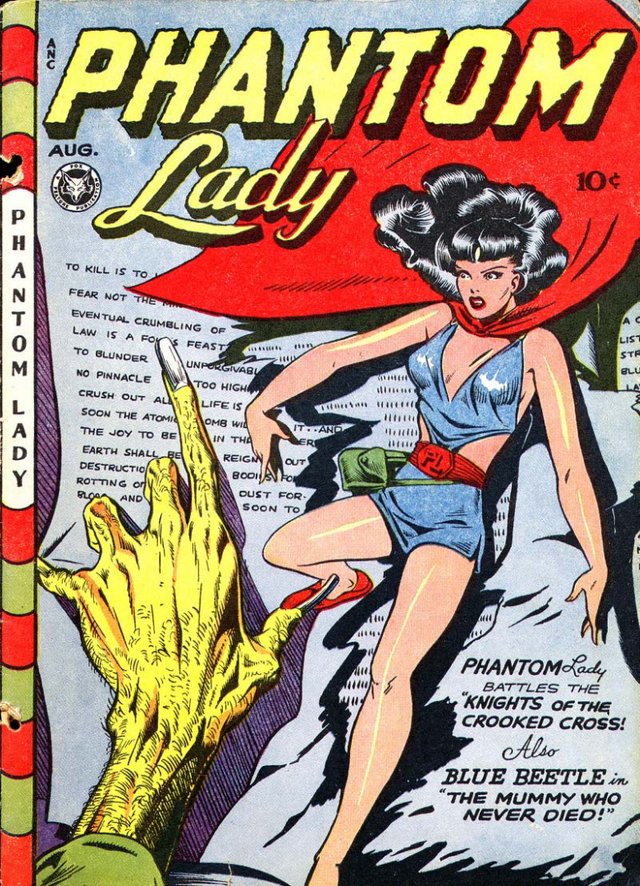Golden Age Superheroines - Phantom Lady
Phantom Lady is a fictional superheroine, one of the first female superhero characters to debut in the 1940s Golden Age of Comic Books. Originally published by Quality Comics, the character was subsequently published by a series of now-defunct comic book companies, and a new version of the character currently appears in books published by DC Comics.

As published by Fox Feature Syndicate in the late 1940s, the busty and scantily-clad Phantom Lady is a notable and controversial example of "good girl art," a style of comic art depicting voluptuous female characters in provocative situations and pin-up poses that contributed to widespread criticism of the medium's effect on children. Phantom Lady was created by the Eisner & Iger studio, one of the first to produce comics on demand for publishers. The character's early adventures were drawn by Arthur Peddy. The character was ranked 49th in Comics Buyer's Guide's "100 Sexiest Women in Comics" list.
Character origin and early publication history
Quality Comics
Phantom Lady first appeared in Quality's Police Comics 01 (Aug, 1941), an anthology title the first issue of which also included the debut of characters such as Plastic Man and the Human Bomb. That issue established her alter ego as Sandra Knight, the beautiful Washington, D.C. debutante daughter of U.S. Senator Henry Knight. The issue established that it was not her first appearance as the Phantom Lady, but it did not go into her origin. Stories published decades later by DC Comics would give her a proper origin, which was altered several times to give Sandra a more active role. Her skimpy costume was eventually explained as a deliberate tactic to distract her usually male foes. Sandra Knight assumed the identity of Phantom Lady in a costume consisting of a green cape and the equivalent of a one-piece yellow swimsuit. She used a "black light projector," a device which allowed her to blind her enemies and make herself invisible. She drove a car whose headlights also projected black light when necessary. She was sometimes assisted by her fiance, Donald Borden, an agent of the U.S. State Department. Phantom Lady ran as one of the features in Police Comics through 23. Arthur Peddy continued as the artist through 13, with Joe Kubert drawing her feature in Police Comics 14-16; Frank Borth on 17-21; Arthur Peddy returned for 22,; and Rudy Palais on 23. Phantom Lady also appeared in Feature Comics 69-71 as part of a crossover with Spider Widow and the Raven.

Fox Feature Syndicate & Star Publications
After Quality stopped publishing the adventures of Phantom Lady, what was now simply Iger Studios believed it owned the character and assigned it to Fox Feature Syndicate, a move that would later cause confusion as to who actually owned the character's copyright. The Fox version which premiered in Phantom Lady 13 (taking over the numbering of Wotalife Comics) is better known to contemporary comic fans than the Quality version because of the "good girl art" of Matt Baker. Baker altered her costume by changing the colors to red and blue, substantially revealing her cleavage, and adding a very short skirt. Fox published Phantom Lady only through issue 23 (Apr, 1949), though the character guest starred in All-Top Comics 8-17, also with art by Baker. Her rogue's gallery in these two Fox titles included the Avenging Skulls; the Fire Fiend; the Killer Clown; Kurtz, the Robbing Robot; the Subway Slayer; and Vulture.

Baker's cover for Phantom Lady 17 (Apr, 1948) was reproduced in Seduction of the Innocent, the 1954 book by Dr. Fredric Wertham denouncing what he saw as the morally corrupting effect of comics on children. The cover, which illustrated Phantom Lady attempting to escape from ropes, was presented by Wertham with a caption that read, "Sexual stimulation by combining 'headlights' with the sadist's dream of tying up a woman." In the meantime, Fox went under and its assets were acquired by other publishers, and a Phantom Lady story from All-Top was then reprinted as a backup feature in Jungle Thrills by Star Publications, which then itself went out of business.
Ajax-Farrell Publications
Ajax-Farrell Publications then published four issues of the second Phantom Lady title, cover dated Dec. 1954/Jan. 1955 through June 1955. The company also published her as a backup feature in two issues of Wonder Boy.

By then, Wertham's efforts had led to a Congressional investigation into the comics industry, and publishers formed the self-censoring Comics Code Authority in the fall of 1954. Some changes were consequently made to the Phantom Lady's costume, so that her cleavage was covered and shorts replaced her skirt.
Read - Police Comics #01 (Quality Comics)

Read - Phantom Lady #13 (Fox Feature Syndicate)

Read - Phantom Lady #01 (Ajax-Farrell)

I didn't know a lot about the Phantom Lady. Thanks for sharing this information, Goldenage!
Upvoted & Followed.
Thank so much